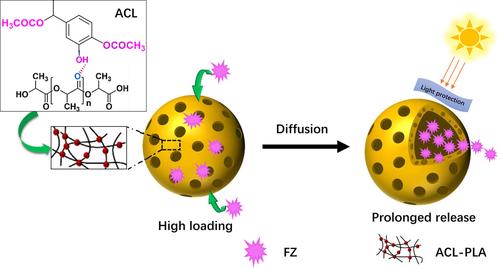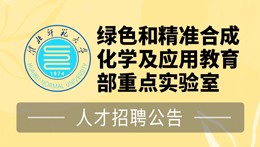当前位置:
X-MOL 学术
›
Pest Manag. Sci.
›
论文详情
Our official English website, www.x-mol.net, welcomes your
feedback! (Note: you will need to create a separate account there.)
Enhancing compatibility of polylactic acid and lignin through acetylation for improving controlled release of pesticide
Pest Management Science ( IF 3.8 ) Pub Date : 2025-01-20 , DOI: 10.1002/ps.8677
Xiongyi Peng, Fangyuan Jiang, Zhili Li
Pest Management Science ( IF 3.8 ) Pub Date : 2025-01-20 , DOI: 10.1002/ps.8677
Xiongyi Peng, Fangyuan Jiang, Zhili Li

|
BACKGROUNDImproving the compatibility between polylactic acid (PLA) and lignin is crucial for developing innovative PLA‐based controlled release systems for pesticides. This study addresses the challenge of enhancing the compatibility of alkali lignin (AL) with PLA by acetylated lignin (ACL). The main aim is to synthesize and evaluate pesticide‐loaded microspheres for controlled release performance using fluazinam (FZ) as the model pesticide.RESULTSWe synthesized three distinct pesticide‐loaded microspheres (FZ@PLA, FZ@AL‐PLA, and FZ@ACL‐PLA). The results demonstrated a significant enhancement in the spherical morphology of FZ@ACL‐PLA compared to FZ@AL‐PLA, attributed to the introduction of acetyl groups that transformed the surface from irregularities to a smooth, rounded, and microporous architecture. This structural modification notably boosted the pesticide loading capacity to 42.44 wt% and entrapment efficiency to 89.20%. Controlled release studies exhibited prolonged release beyond 30 days without equilibrium attainment for FZ@ACL‐PLA. This was facilitated by hydrogen bonding between ACL‐PLA and FZ, coupled with a spatial site‐blocking effect, effectively restraining abrupt pesticide release. Kinetic analysis revealed Fickian diffusion as the primary release mechanism at moderate temperatures and anomalous transport at elevated temperatures. Additionally, FZ@ACL‐PLA demonstrated commendable storage stability and photostability.CONCLUSIONThe study underscores the efficacy of ACL‐modified PLA microspheres in efficiently entrapping FZ and enabling controlled release. The findings offer crucial insights for developing PLA‐based pesticide‐controlled release systems, highlighting the significance of ACL in enhancing pesticide loading, entrapment efficiency, and controlled release performance. © 2025 Society of Chemical Industry.
中文翻译:

通过乙酰化增强聚乳酸与木质素的相容性,以改善农药的控释
背景提高聚乳酸 (PLA) 和木质素之间的相容性对于开发基于 PLA 的创新农药控释系统至关重要。本研究解决了通过乙酰化木质素 (ACL) 增强碱木质素 (AL) 与 PLA 相容性的挑战。主要目的是使用氟嗪南 (FZ) 作为模型农药合成和评估载有农药的微球的控释性能。结果我们合成了三种不同的载有农药的微球(FZ@PLA、FZ@AL-PLA 和 FZ@ACL-PLA)。结果表明,与 FZ@AL-PLA 相比,FZ@ACL-PLA 的球形形态显着增强,这归因于乙酰基的引入,乙酰基的引入将表面从不规则转变为光滑、圆形和微孔结构。这种结构改性显著提高了农药负载量至 42.44 wt%,包埋率提高至 89.20%。控释研究显示 FZ@ACL-PLA 的缓释超过 30 天而未达到平衡。ACL-PLA 和 FZ 之间的氢键以及空间位点阻断效应促进了这一过程,从而有效抑制了农药的突然释放。动力学分析显示,Fickian 扩散是中等温度下的主要释放机制,而高温下是异常传输。此外,FZ@ACL-PLA 表现出值得称道的储存稳定性和光稳定性。结论该研究强调了 ACL 修饰的 PLA 微球在有效捕获 FZ 和实现控释方面的功效。 这些发现为开发基于 PLA 的农药控释系统提供了重要见解,突出了 ACL 在提高农药负载、捕获效率和控释性能方面的重要性。© 2025 化工学会.
更新日期:2025-01-20
中文翻译:

通过乙酰化增强聚乳酸与木质素的相容性,以改善农药的控释
背景提高聚乳酸 (PLA) 和木质素之间的相容性对于开发基于 PLA 的创新农药控释系统至关重要。本研究解决了通过乙酰化木质素 (ACL) 增强碱木质素 (AL) 与 PLA 相容性的挑战。主要目的是使用氟嗪南 (FZ) 作为模型农药合成和评估载有农药的微球的控释性能。结果我们合成了三种不同的载有农药的微球(FZ@PLA、FZ@AL-PLA 和 FZ@ACL-PLA)。结果表明,与 FZ@AL-PLA 相比,FZ@ACL-PLA 的球形形态显着增强,这归因于乙酰基的引入,乙酰基的引入将表面从不规则转变为光滑、圆形和微孔结构。这种结构改性显著提高了农药负载量至 42.44 wt%,包埋率提高至 89.20%。控释研究显示 FZ@ACL-PLA 的缓释超过 30 天而未达到平衡。ACL-PLA 和 FZ 之间的氢键以及空间位点阻断效应促进了这一过程,从而有效抑制了农药的突然释放。动力学分析显示,Fickian 扩散是中等温度下的主要释放机制,而高温下是异常传输。此外,FZ@ACL-PLA 表现出值得称道的储存稳定性和光稳定性。结论该研究强调了 ACL 修饰的 PLA 微球在有效捕获 FZ 和实现控释方面的功效。 这些发现为开发基于 PLA 的农药控释系统提供了重要见解,突出了 ACL 在提高农药负载、捕获效率和控释性能方面的重要性。© 2025 化工学会.































 京公网安备 11010802027423号
京公网安备 11010802027423号